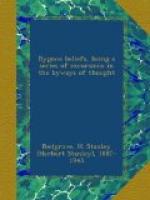[1] Professor WILHELM WINDELBAND, Ph.D.: “Present-Day Mysticism,” The Quest, vol. iv. (1913), P. 205.
Alchemy, with its four Aristotelian or scholastic elements and its three mystical principles—sulphur, mercury, salt,—must be cited as the outstanding product of the combined influence of mysticism and scholasticism: of mysticism, which postulated the unity of the Cosmos, and hence taught that everything natural is the expressive image and type of some supernatural reality; of scholasticism, which taught men to rely upon deduction and to restrict experimentation to the smallest possible limits.
The mind naturally proceeds from the known, or from what is supposed to be known, to the unknown. Indeed, as I have already indicated, it must so proceed if truth is to be gained. Now what did the men of the Middle Ages regard as falling into the category of the known? Why, surely, the truths of revealed religion, whether accepted upon authority or upon the evidence of their own experience. The realm of spiritual and moral reality: there, they felt, they were on firm ground. Nature was a realm unknown; but they had analogy to guide, or, rather, misguide them. Nevertheless if, as we know, it misguided, this was not, I think, because the mystical doctrine of the correspondence between the spiritual and the natural is unsound, but because these ancient seekers into Nature’s secrets knew so little, and so frequently misapplied what they did know. So alchemical philosophy arose and became systematised, with its wonderful endeavour to perfect the base metals by the Philosopher’s Stone—the concentrated Essence of Nature,—as man’s soul is perfected through the life-giving power of JESUS CHRIST.
I want, in conclusion to these brief introductory remarks, to say a few words concerning phallicism in connection with my topic. For some “tender-minded"[1] and, to my thought, obscure, reason the subject is tabooed. Even the British Museum does not include works on phallicism in its catalogue, and special permission has to be obtained to consult them. Yet the subject is of vast importance as concerns the origin and development of religion and philosophy, and the extent of phallic worship may be gathered from the widespread occurrence of obelisks and similar objects amongst ancient relics. Our own maypole dances may be instanced as one survival of the ancient worship of the male generative principle.




